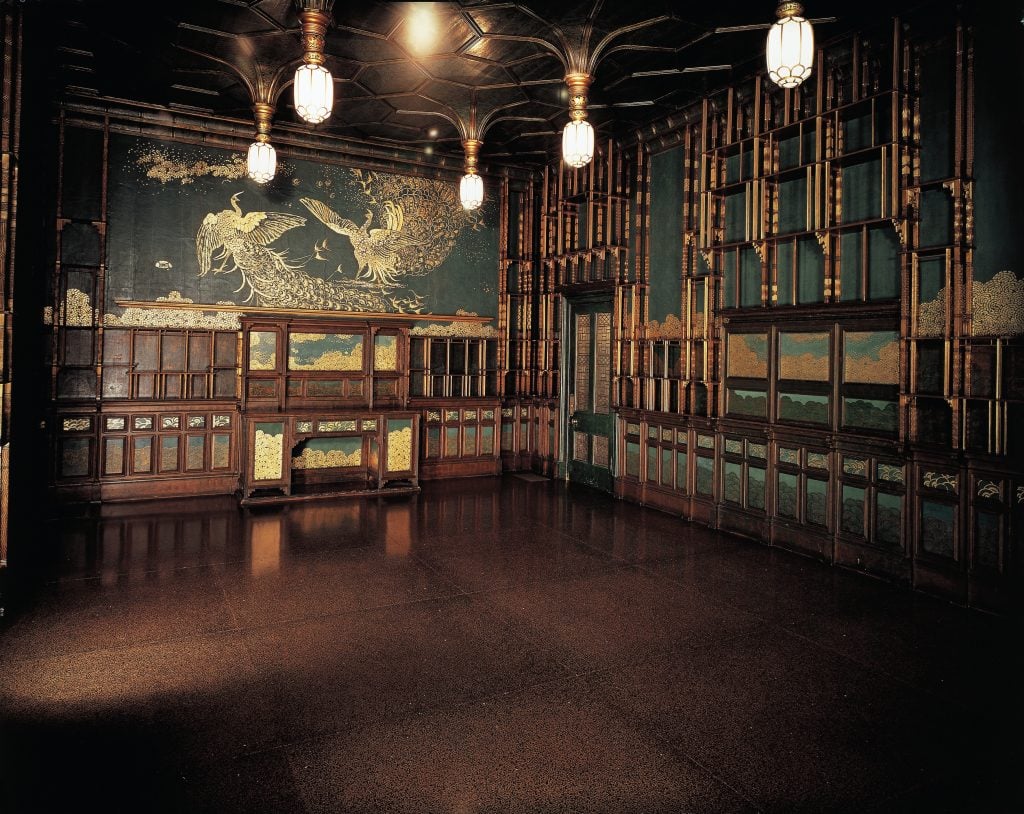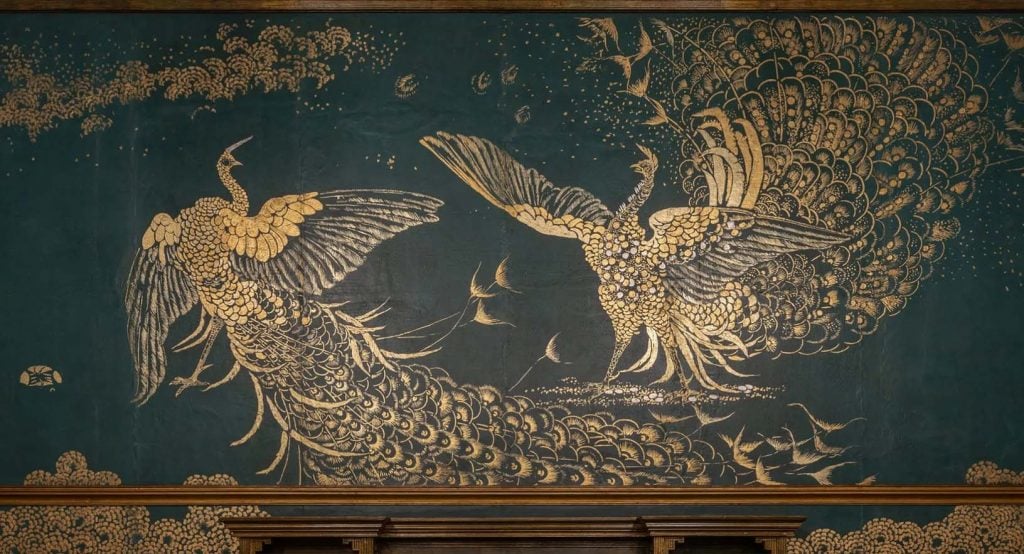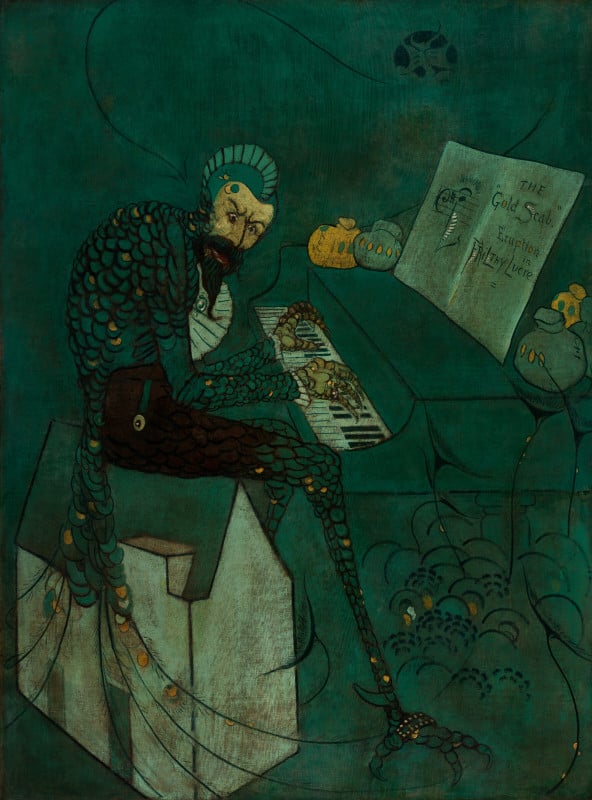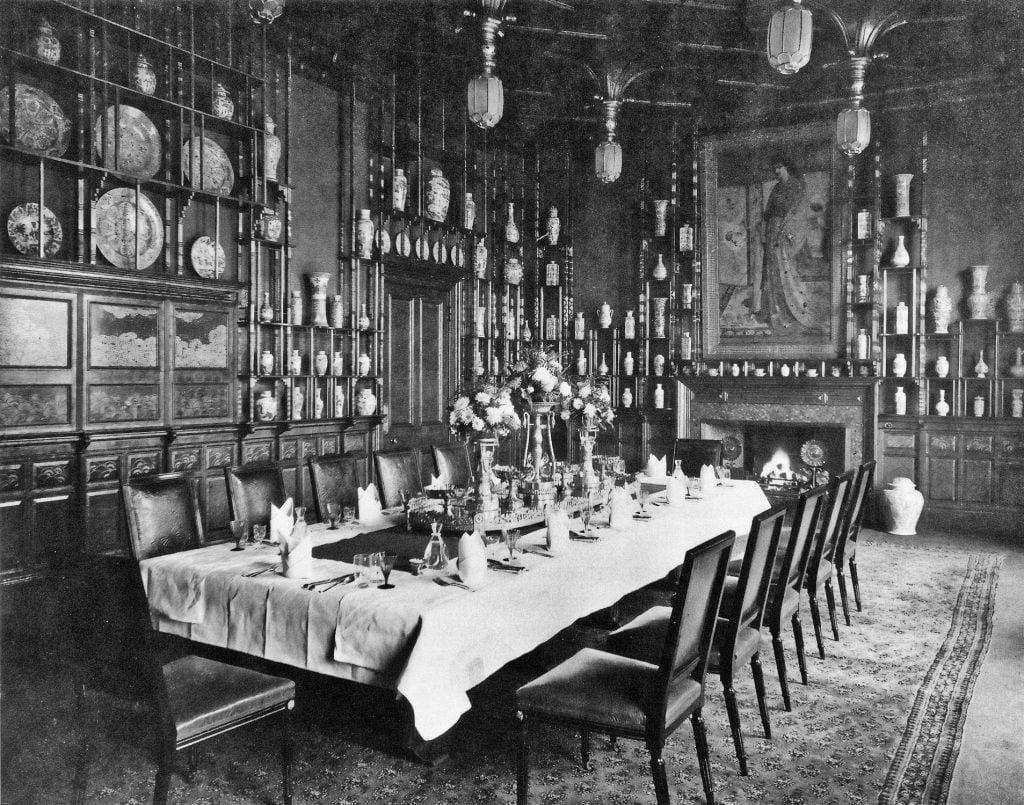Art History
James McNeill Whistler’s ‘The Peacock Room’ Is a Glittering Masterpiece With a Dark History
The Peacock Room, now in the collection of the National Museum of Asian Art, has a surprisingly fractious history. A new exhibition "Ruffled Feathers" in D.C. delves into the interior's complex genesis.

In the heart of downtown Washington D.C. hides an art lover’s hidden gem with a scandalous history. Tucked inside the Freer Gallery of Art, home to the National Museum of Asian Art, is the Peacock Room, a late 19th-century blue-green room ornately painted with golden adornments. Historians consider it one of the premiere extant interiors of the Aesthetic Movement and one of the leading embodiments of the Anglo-Japanese style, which was in vogue in the U.K. during the mid-to-late 1800s.

Installation view of “Ruffled Feathers” at the Freer Gallery. Courtesy of the National Museum of Asian Art, Smithsonian Institution.
American painter James McNeill Whistler and English architect Thomas Jeckyll created the room, which Whistler titled Harmony in Blue and Gold: The Peacock Room. With Prussian blue walls, copper-green overglazing, and Dutch metal designed to look like gold leaf, the room is symphonic in its overall effect.
Created from 1876 to 1877, the room was designed as the dining room of British shipping magnate Frederick Richards Leyland for his Kensington townhouse. Architect Richard Norman Shaw was hired to lead the renovation and Shaw brought on fellow architect Thomas Jeckyll to design the dining room. Jeckyll conceptualized the room as a Porzellanzimmer (porcelain room) to display Leyland’s collection of blue and white porcelain, dating primarily from the Qing dynasty.

James McNeill Whistler, The Princess from the Land of Porcelain (1863). National Museum of Asian Art
He lined the walls with ornate leather wall hangings that had been part of the dowry of Catherine of Aragon, covered with the red roses of the Tudor heraldry. He hung gas light fixtures from the ceiling and added a red-trimmed rug to the floor. Still a defining feature of the room, he also fabricated spindle walnut shelves to display the porcelain collection. Originally, Whistler’s involvement had been peripheral; on one wall, over a fireplace, the artist’s painting Rose and Silver: The Princess from the Land of Porcelain was positioned as the focal point of the room. Leyland was one of Whistler’s first patrons (he painted Leyland’s portrait in 1870) and was, at the time, also tasked with creating decorative designs for the entryway to the London home.

James McNeil Whistler, Arrangement in Black: Portrait of F. R. Leyland (1870–1873). Courtesy of the National Museum of Asian Art.
Fatefully, however, when Jeckyll was nearly finished with the room a sudden illness compelled him to abandon the project. Whistler offered his assistance, which Leyland agreed to. But rather than seeing Jeckyll’s plans through, Whistler had ambitions all his own—ones that would ultimately fracture his relationship with Leyland beyond repair and cause lasting reverberations.
Currently on view at the National Museum of Asian Art, the exhibition “Ruffled Feathers” delves into Peacock Room’s quarrelsome genesis and the barbed relationship between artist and patron (through January 31, 2027). Recently we took a closer look at this gilded masterpiece and found three facts that give insight into the Peacock Room’s scintillating history (including its transatlantic journey).
Whistler Goes Rogue, Adds Fighting Fowls

Whistler’s addition of Art and Money (1876).
After agreeing to some minor alterations in Jeckyll’s plans, Leyland left Whistler in London to complete the room and set off for his property in Liverpool. While Whistler had promised to add a few touches of yellow to the red roses on the leather wall hangings and a few decorative flourishes to the walls, he got carried away in his solitude. He recalled, “I went on—without design or sketch—it grew as I painted. And toward the end, I reached such a point of perfection—putting in every touch with such freedom—that when I came round to the corner where I started, why, I had to paint part of it over again, as the difference would have been too marked.”
Upon his return, Leyland was infuriated by Whistler’s audacious revisions. What’s more, the artist charged him with a fee of 2,000 guineas for the unauthorized work. The artist and patron fought furiously, both over his alterations, and Whistler’s fee, and the artist was fired. But Whistler’s boldness was not dampened, nor was his vision for the room; the artist even snuck back into the home and added two fighting peacocks to the wall, a metaphor for his cantankerous relationship with Leyland. He titled the addition Art and Money or alternately, The Story of the Room.
Whistler’s Debts and His Artistic Vengeance

James McNeill Whistler, The Gold Scab: Eruption in Frilthy Lucre (The Creditor) (1879). Collection of the Fine Arts Museum of San Francisco.
In 1879, Whistler, a notorious spendthrift, was forced into bankruptcy, and the creditor at his heels was none other than Leyland, his former patron. When creditors came to inventory Whistler’s assets, they were confronted with Whistler’s latest work, The Gold Scab: Eruption in Frilthy Lucre (The Creditor), a large emerald-hued painting depicting Leyland as a demon-like peacock perched upon Whistler’s home and hunched over a piano. The palette for the painting is the same as the Peacock Room, while the work’s title is a biblical allusion to “filthy lucre” which scripture warns against as a grave temptation. The Gold Scab was one more in a long string of dramas stemming from the Peacock Room’s unexpected completion. Whistler had remained, perhaps mischievously, endeared to Leyland’s wife Frances, who had left her husband, a notorious philanderer, in the intervening years. And sadly, especially, was the demise of Jeckyll, who already with slipping mental health, was shaken irrevocably by the destruction of what would be his final design. The epic drama behind the Peacock Room has continued to fascinate new generations. In 2013, artist Darren Waterston, inspired by the shocking history of the room, created his own interpretation with his installation Filthy Lucre which reimagines the Peacock Room in decadent ruins.
An Artist’s Advice Saved the Imperiled Peacock Room From Destruction

The Peacock Room at 49 Prince’s Gate, London, ca. 1890
Leyland was a notorious philanderer, a vice that ultimately threw the fate of the Peacock Room into jeopardy. His beleaguered wife Frances filed for a formal separation. Leyland would soon after father a son with his still-married mistress Rose Caldecott. With another mistress, Anne Wooster, he would have two more sons. Leyland stipulated that Wooster and the children be allotted 20,000 pounds annually upon his passing. To allow for that liquidity his family chose to sell the Kensignton townhouse with the Peacock Room in situ after Leyland’s death in 1892. The home was purchased by a well-established widow named Blanche Watney who considered Whistler’s room a garish eyesore. She had plans to tear it out, but the Briths artist and illustrator W. Graham Robertson intervened, suggesting it might have a monetary value. In 1904, Watney, through dealers called Messers Obach & Co, sold the room to the American collector Charles Lang Freer for the jaw-dropping sum of 10,000 guineas (equivalent to about £1.5 million). Freer, a Michigan industrialist, dismantled the room and shipped it to his Detroit mansion, where he displayed his collection of Asian art. The room was ultimately moved once more to the Freer Gallery, in 1923, as part of a gift to the Smithsonian.





